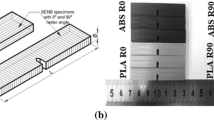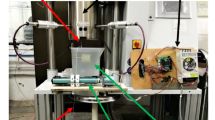Abstract
Additive manufacturing is unquestionably gaining importance in industry. Due to the layer by layer deposit process, it usually leads to an anisotropic material. A question of importance is whether Linear Elastic Fracture Mechanics can be used to assess their resistance to fracture. In this paper, we investigate this point on polycarbonate printed by Fused Deposition Modelling focusing on a criss-crossed deposit pattern. Thanks to tensile and fracture experiments instrumented by Digital Image Correlation, the material is evidenced to be linear elastic until fracture, nearly isotropic in the 2D printing plane but with a strong fracture anisotropy, leading to systematic crack kinking along the weakest plane. The Stress Intensity Factors evolution is measured across the kink and shown to be in agreement with Amestoy-Leblond’s formula. The fracture toughness is observed to be larger than the bulk value, in agreement with irreversible damage and plasticity that are clearly observable at the scale of the threads.










Similar content being viewed by others
Notes
In other words, the crack tip must be far enough of the sample boundary.
For dimensional reasons and linearity of the problem with the loading, the value of \(\mathcal{L}\) depends only on the sample geometry and can be estimated quite straightforwardly by Finite Elements. The value we obtained in this way, has been checked to be in agreement with the literature (Leevers and Radon 1982).
References
Amestoy M, Leblond JB (1992) Crack paths in plane situations—II. Detailed form of the expansion of the stress intensity factors. Int J Solids Struct 29:465–501
Ashby M (1989) Overview no. 80: on the engineering properties of materials. Acta Metall 37(5):1273–1293
Balit Y, Charkaluk E, Constantinescu A (2020) Digital image correlation for microstructural analysis of deformation pattern in additively manufactured 316L thin walls. Addit Manuf 31:100862
Besnard G, Hild F, Roux S (2006) “finite-element” displacement fields analysis from digital images: application to portevin–le châtelier bands. Exp Mech 46(6):789–803
Brodnik N, Hsueh C-J, Faber K, Bourdin B, Ravichandran G, Bhattacharya K (2020) Guiding and trapping cracks with compliant inclusions for enhancing toughness of brittle composite materials. J Appl Mech 87(3):031018
Chambolle A, Francfort G, Marigo JJ (2009) When and how do cracks propagate? J Mech Phys Solids 57(9):1614–1622
Dimas L, Bratzel G, Eylon I, Buehler M (2015) Tough composites inspired by mineralized natural materials: computation, 3D printing, and testing. Adv Funct Mater 23(36):4629–4638
Dizon JRC, Espera AH Jr, Chen Q, Advincula RC (2018) Mechanical characterization of 3D-printed polymers. Addit Manuf 20:44–67
Domingo-Espin M, Puigoriol-Forcada JM, Garcia-Granada AA, Llumà J, Borros S, Reyes G (2015) Mechanical property characterization and simulation of fused deposition modeling polycarbonate parts. Mater Des 83:670–677
Gardan J, Makke A, Recho N (2018) Improving the fracture toughness of 3D printed thermoplastic polymers by fused deposition modeling. Int J Fract 210(1–2):1–15
Gonzalez J, Lambros J (2013) Crack path selection in microstructurally tailored inhomogeneous polymers. Exp Mech 53(4):619–634
Hakim V, Karma A (2009) Laws of crack motion and phase-field models of fracture. J Mech Phys Solids 57(2):342–368
Hamam R, Hild F, Roux S (2007) Stress intensity factor gauging by digital image correlation: application in cyclic fatigue. Strain 43(3):181–192
Ibarra A, Roman B, Melo F (2016) The tearing path in a thin anisotropic sheet from two pulling points: Wulff’s view. Soft Matter 12:5979–5985
Irwin GR (1957) Analysis of stresses and strains near the end of a crack traversing a plate. J Appl Mech 24:361–364
Kim A, Bosnyak CP, Chudnovsky A (1994) Effects of weathering, scale, and rate of loading on polycarbonate fracture toughness. J Appl Polym Sci 51(11):1841–1848
Kok Y, Tan XP, Wang P, Nai M, Loh NH, Liu E, Tor SB (2018) Anisotropy and heterogeneity of microstructure and mechanical properties in metal additive manufacturing: a critical review. Mater Des 139:565–586
Lazarus V, Leblond JB, Mouchrif SE (2001) Crack front rotation and segmentation in mixed mode I+III or I+II+III - part I: calculation of stress intensity factor. J Mech Phys Solids 49(7):1399–1420
Leblond JB (1989) Crack paths in plane situations—I. General form of the expansion of the stress intensity factors. Int J Solids Struct 25:1311–1325
Leblond JB (1999) Crack paths in three-dimensional elastic solids. I: two-term expansion of the stress intensity factors-application to crack path stability in hydraulic fracturing. Int J Solids Struct 36(1):79–103
Leblond JB, Lazarus V, Mouchrif SE (1999) Crack paths in three-dimensional elastic solids. II. Three-term expansion of the stress intensity factors—applications and perspectives. Int J Solids Struct 36(1):105–142
Leevers P, Radon J (1982) Inherent stress biaxiality in various fracture specimen geometries. Int J Fract 19:311–325
Leguillon D (1993) Asymptotic and numerical analysis of crack branching in non-isotropic materials. Eur J Mech A/Solids 12:33–51
Li B, Maurini C (2019) Crack kinking in a variational phase-field model of brittle fracture with strongly anisotropic surface energy. J Mech Phys Solids 125:502–522
Li B, Peco C, Millán D, Arias I, Arroyo M (2015) Phase-field modeling and simulation of fracture in brittle materials with strongly anisotropic surface energy. Int J Numer Methods Eng 102(3–4):711–727
Martin J, Fiore B, Erb R (2015) Guiding and trapping cracks with compliant inclusions for enhancing toughness of brittle composite materials. Nat Commun 6(1):1–7
Mesgarnejad A, Pan C, Erb R, Shefelbine S, Karma A (2020) Crack path selection in orientationally ordered composites. Phys Rev E 102(1):013004
Ngo TD, Kashani A, Imbalzano G, Nguyen KT, Hui D (2018) Additive manufacturing (3D printing): a review of materials, methods, applications and challenges. Compos Part B 143:172–196
Nguejio J, Szmytka F, Hallais S, Tanguy A, Nardone S, Godino Martinez M (2019) Comparison of microstructure features and mechanical properties for additive manufactured and wrought nickel alloys. Mater Sci Eng A 764:138214
Palaniswamy K, Knauss WG (1975) Crack extension in brittle solids. In: Nasser SN (ed) Mechanics today, vol 4. Pergamon Press, New York, p 87
Réthoré J (2015) Automatic crack tip detection and stress intensity factors estimation of curved cracks from digital images. Int J Numer Methods Eng 103(7):516–534
Réthoré J (2018). Ufreckles. https://doi.org/10.5281/zenodo.1433776
Roux S, Réthoré J, Hild F (2009) Digital image correlation and fracture: an advanced technique for estimating stress intensity factors of 2D and 3D cracks. J Phys D 42(21):1–38
Roux-Langlois C, Gravouil A, Baietto MC, Réthoré J, Mathieu F, Hild F, Roux S (2015) DIC identification and X-FEM simulation of fatigue crack growth based on the Williams’ series. Int J Solids Struct 53:38–47
Song Y, Li Y, Song W, Yee K, Lee KY, Tagarielli VL (2017) Measurements of the mechanical response of unidirectional 3D-printed pla. Mater Des 123:154–164
Takei A, Roman B, Bico J, Hamm E, Melo F (2013) Forbidden directions for the fracture of thin anisotropic sheets: an analogy with the wulff plot. Phys Rev Lett 110:144301
Ting TCt, (1996) Anisotropic elasticity: theory and applications, vol 45. Oxford University Press, Oxford
Williams ML (1952) Stress singularities resulting from various boundary conditions in angular corners of plates in extension. J Appl Mech 19:526
Wang N, Xia S (2017) Cohesive fracture of elastically heterogeneous materials: an integrative modeling and experimental study. J Mec Phys Solids 98:87–105
Zareiyan B, Khoshnevis B (2017) Interlayer adhesion and strength of structures in contour crafting-effects of aggregate size, extrusion rate, and layer thickness. Autom Constr 81:112–121
Ziemian C, Sharma M, Ziemian S (2012) Anisotropic mechanical properties of abs parts fabricated by fused deposition modelling. Mech Eng 23:1–24
Zou R, Xia Y, Liu S, Hu P, Hou W, Hu Q, Shan C (2016) Isotropic and anisotropic elasticity and yielding of 3D printed material. Compos Part B 99:506–513
Acknowledgements
The authors wish to thank Julien Réthoré and Raphaël Langlois for their advice on DIC. Our experimental support team, Nicolas Thurieau and Lahcène Cherfa, and the interns, Safwan Alblihed and Anis Ben Amor, are acknowledged for their help with the set up of the experiments. The support of Direction Génerale de l’Armement (DGA) and Agence de l’Innovation de la Défense (AID) is gratefully acknowledged.
Author information
Authors and Affiliations
Corresponding author
Additional information
Publisher's Note
Springer Nature remains neutral with regard to jurisdictional claims in published maps and institutional affiliations.
Appendix: Numerical values of the function \(F_{pq}(\varphi )\) for an isotropic material
Appendix: Numerical values of the function \(F_{pq}(\varphi )\) for an isotropic material
The paper of Amestoy and Leblond (1992) provides two methods to obtain the values of \(F_{pq}(\varphi )\): the first is a semi-analytical method in which their values can be obtained by solving some integral equations coupled with Anderson’s formula (Eqs. (34)\(_{1}\), (35)\(_{1}\), (36), (39) in there); the second is to use their expression under the form of a 21 terms-serie of \(m=\varphi /\pi \) (Eq. (66) in there).
The values we used here are those obtained by the first method. They can be downloaded as supplemental material. But the series provided in Amestoy and Leblond (1992) should have been used as well without any change in our final conclusions, as both methods yield (without surprise) quiet exactly the same values (see Fig. 11).
Universal Functions \(F_{pq}(\varphi )\) obtained by two different methods from Amestoy and Leblond (1992)
Rights and permissions
About this article
Cite this article
Corre, T., Lazarus, V. Kinked crack paths in polycarbonate samples printed by fused deposition modelling using criss-cross patterns. Int J Fract 230, 19–31 (2021). https://doi.org/10.1007/s10704-021-00518-x
Received:
Accepted:
Published:
Issue Date:
DOI: https://doi.org/10.1007/s10704-021-00518-x





